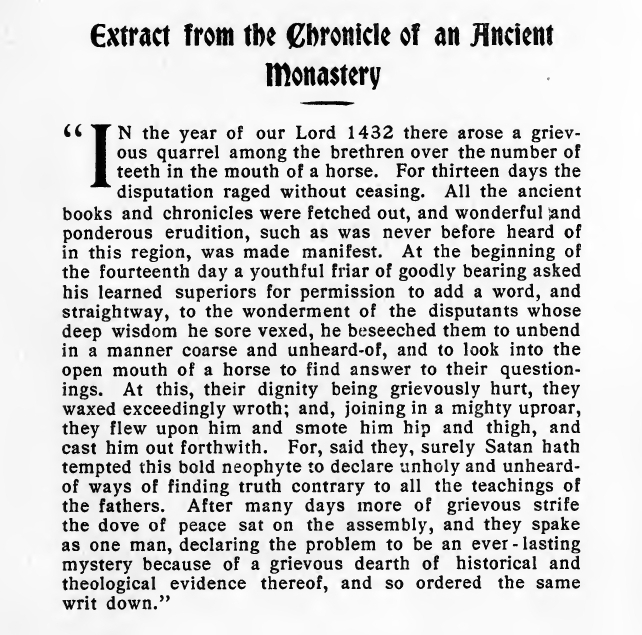HORSE'S TEETH
 |
In the year of our Lord 1432, there arose a grievous quarrel among the brethren over the number of teeth in the mouth of a horse. For thirteen days the disputation raged without ceasing. All the ancient books and chronicles were fetched out, and wonderful and ponderous erudition such as was never before heard of in this region was made manifest. At the beginning of the fourteenth day, a youthful friar of goodly bearing asked his learned superiors for permission to add a word, and straightway, to the wonderment of the disputants, whose deep wisdom he sore vexed, he beseeched them to unbend in a manner coarse and unheard-of and to look in the open mouth of a horse and find answer to their questionings. At this, their dignity being grievously hurt, they waxed exceeding wroth; and, joining in a mighty uproar, they flew upon him and smote him, hip and thigh, and cast him out forthwith. For, said they, surely Satan hath tempted this bold neophyte to declare unholy and unheard-of ways of finding truth, contrary to all the teachings of the fathers. After many days more of grievous strife, the dove of peace sat on the assembly, and they as one man declaring the problem to be an everlasting mystery because of a grievous dearth of historical and theological evidence thereof, so ordered the same writ down.
—Francis Bacon, 1592 (?).
Is this a scientific urban legend?
This text is taken from a compilation of science essays, which had incomplete documentation of the source of this story. I have strong suspicions that the attribution of this passage to Francis Bacon cannot be documented. Perhaps this was written by someone relating a tale "said to have been told" by Francis Bacon. If so, who?Indeed, some sources attribute this to Francis Bacon (1561-1626), others to Roger Bacon (1290-1222) but the association with Roger Bacon makes more sense. Still, the internal reference to the event happening in 1432, suggests it happened after Roger died. The date 1592 would fall within the lifetime of Francis. Is this another example of the fact that these poor fellows are often mistaken for each other?
Very often, when one seeks sources, such stories are found to be "urban legends" unfounded in fact. I have similar suspicions about the often-related story that medieval scholastic academics debated "how many angels can dance on the head (point?) of a pin?" I cannot document that any such arguments took place, nor have I seen any such documentation. Who started this story? But it does sound like something a critic of scholasticsm would use to characterize or parody the empty silliness of their sober arguments. The parody is quite apt. Apparently scholastics did argue whether Adam had a navel and whether angels defecate. My skeptical comments should not be taken as an apologetic for scholasticism, for its "scholars" were prone to concoct arguments that made them look very foolish.
I will not speculate on whether the dust-bunnies in my closet are angel-poo.
Feedback.
Robert O'Shea writes:The earliest (still apparently secondary) source for the quotation I have found is: Mees, C. E. K. (1934). Scientific thought and social reconstruction. Electrical Engineering, 53, 383-384. But see below.
Others are engaged in a so-far futile search for the source of this story. See google answers and this note.
2015. A bibliophile reader reports pushing back the source of this story to 1901.
I was doing some searches today. It shows up first unattributed in the Monthly Journal of the International Association of Machinists, Volume 13, No. 3 from 1901 on p 129: Chronicle of an Ancient Monastery.
A few years later it occurs again unattributed in "Jack London at Yale" Edited by the State Secretary of the Socialist Party of Connecticut and published by the Connecticut State Committee in 1906. (I have attached the page from this site): Extract from the Chronicle of an Ancient Monastery. The story is on page 12 of the document.)
Here's the page from this book:

It then shows up in The Public, Volume 10, p 17.
From this it looks like a parable written by some socialists and playing on prejudices of the Middle Ages.
It certainly seemed to be popular in socialist circles in the early 20th century. But I'll bet it originated even earler, but unlikely to have been the work of either Francis or Roger Bacon. We have yet to place the blame for that false attribution.
This illustrates how stories proliferate if they tap into reader's beliefs or prejudices. And along the way someone feels compelled to give it added weight by falsely linking it to some well known famous person.
Return to Donald Simanek's page.